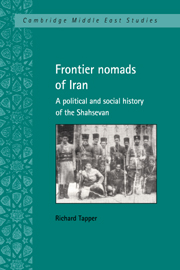Book contents
- Frontmatter
- Contents
- List of illustrations
- Preface
- Acknowledgments
- Note on transliteration
- Glossary
- 1 Writing tribal history
- PART I The Safavid state and the origins of the Shahsevan
- PART II The rise of the Shahsevan confederacy
- PART III The Shahsevan tribes in the Great Game
- PART IV The end of the tribal confederacy
- Appendices
- 1 The Shahsevan of Kharaqan and Khamseh
- 2 Lists and histories of Shahsevan tribes
- 3 Some Shahsevan voices
- Bibliography
- Index of topics
- Index of places, peoples, persons, dynasties, parties, companies
- Index of authors quoted or discussed
- Index of tribal names
- Plate section
1 - The Shahsevan of Kharaqan and Khamseh
Published online by Cambridge University Press: 05 March 2012
- Frontmatter
- Contents
- List of illustrations
- Preface
- Acknowledgments
- Note on transliteration
- Glossary
- 1 Writing tribal history
- PART I The Safavid state and the origins of the Shahsevan
- PART II The rise of the Shahsevan confederacy
- PART III The Shahsevan tribes in the Great Game
- PART IV The end of the tribal confederacy
- Appendices
- 1 The Shahsevan of Kharaqan and Khamseh
- 2 Lists and histories of Shahsevan tribes
- 3 Some Shahsevan voices
- Bibliography
- Index of topics
- Index of places, peoples, persons, dynasties, parties, companies
- Index of authors quoted or discussed
- Index of tribal names
- Plate section
Summary
In the nineteenth and twentieth centuries there have been two distinct sets of tribes called Shahsevan, though there is evidence that the ancestors of most of the tribes in each set co-existed in the Ardabil region in the early eighteenth century. No detailed ethnographic study has been conducted among the Shahsevan tribes of Kharaqan and Khamseh, and I have no personal knowledge of them, but it seems appropriate here to summarize what is known of their origins and traditions.
In Chapters Five and Seven I discussed evidence that Nader Afshar removed Shaqaqi, Inallu Shahsevan and Afshar tribal groups from the Moghan–Ardabil region in 1730. The Shaqaqi returned by the 1750s, though they settled around Sarab to the south of their former home. There is no record that the Inallu or Afshar groups ever came all the way back from Khorasan; rather, evidence indicates that they returned to the Khamseh and Kharaqan regions, where they settled and have remained, and constitute the second of the two major groups of tribes bearing the name Shahsevan.
In these regions, centred approximately on Zanjan, Qazvin and Saveh, there were by the middle of the nineteenth century five tribal groups known as Shahsevan: Inallu, Baghdadi, Qurt-Beyli, Doveiran and Afshar Doveiran. At least three of these groups appear to have been in the Ardabil–Moghan region early in the previous century, along with the ancestors of the Shahsevan tribes there now.
- Type
- Chapter
- Information
- Frontier Nomads of IranA Political and Social History of the Shahsevan, pp. 349 - 355Publisher: Cambridge University PressPrint publication year: 1997



